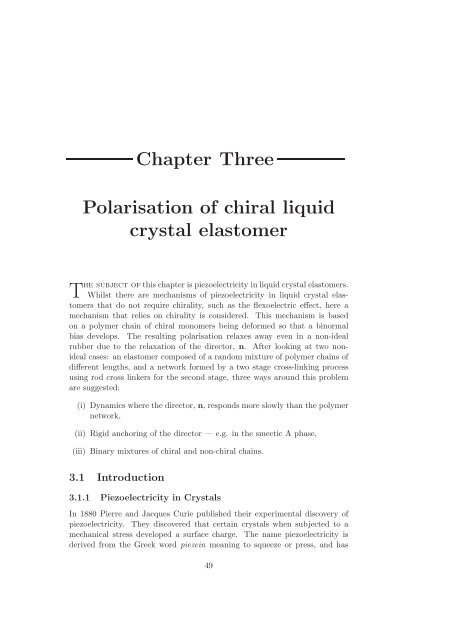Statistical models of elasticity in main chain and smectic liquid ...
Statistical models of elasticity in main chain and smectic liquid ...
Statistical models of elasticity in main chain and smectic liquid ...
You also want an ePaper? Increase the reach of your titles
YUMPU automatically turns print PDFs into web optimized ePapers that Google loves.
Chapter ThreePolarisation <strong>of</strong> chiral <strong>liquid</strong>crystal elastomerThe subject <strong>of</strong>thischapterispiezoelectricity <strong>in</strong><strong>liquid</strong>crystal elastomers.Whilst there are mechanisms <strong>of</strong> piezoelectricity <strong>in</strong> <strong>liquid</strong> crystal elastomersthat do not require chirality, such as the flexoelectric effect, here amechanism that relies on chirality is considered. This mechanism is basedon a polymer cha<strong>in</strong> <strong>of</strong> chiral monomers be<strong>in</strong>g deformed so that a b<strong>in</strong>ormalbias develops. The result<strong>in</strong>g polarisation relaxes away even <strong>in</strong> a non-idealrubber due to the relaxation <strong>of</strong> the director, n. After look<strong>in</strong>g at two nonidealcases: an elastomer composed <strong>of</strong> a r<strong>and</strong>om mixture <strong>of</strong> polymer cha<strong>in</strong>s <strong>of</strong>different lengths, <strong>and</strong> a network formed by a two stage cross-l<strong>in</strong>k<strong>in</strong>g processus<strong>in</strong>g rod cross l<strong>in</strong>kers for the second stage, three ways around this problemare suggested:(i) Dynamics where the director, n, responds more slowly than the polymernetwork,(ii) Rigid anchor<strong>in</strong>g <strong>of</strong> the director — e.g. <strong>in</strong> the <strong>smectic</strong> A phase,(iii) B<strong>in</strong>ary mixtures <strong>of</strong> chiral <strong>and</strong> non-chiral cha<strong>in</strong>s.3.1 Introduction3.1.1 Piezoelectricity <strong>in</strong> CrystalsIn 1880 Pierre <strong>and</strong> Jacques Curie published their experimental discovery <strong>of</strong>piezoelectricity. They discovered that certa<strong>in</strong> crystals when subjected to amechanical stress developed a surface charge. The name piezoelectricity isderived from the Greek word pieze<strong>in</strong> mean<strong>in</strong>g to squeeze or press, <strong>and</strong> has49
















